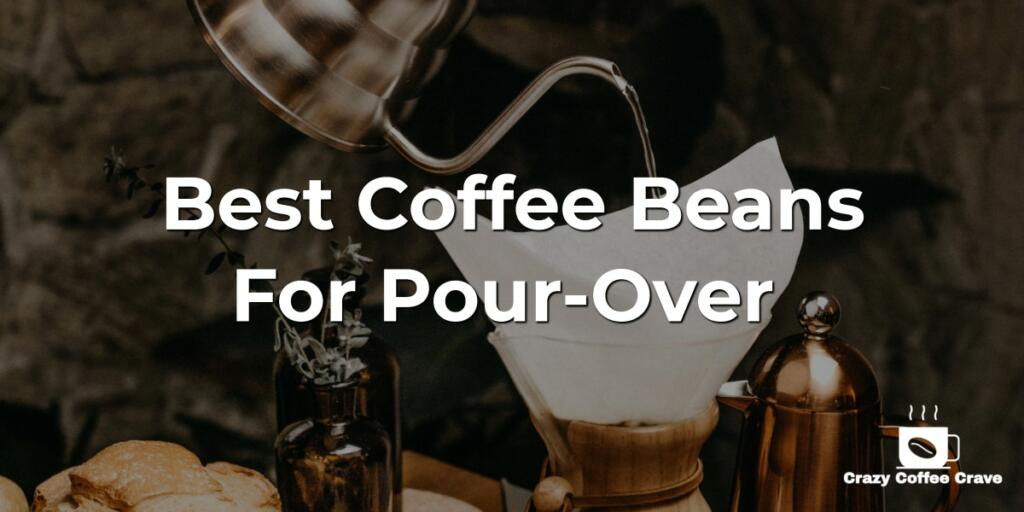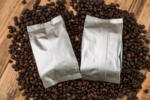Waking up to the inviting aroma of a perfectly brewed coffee is a cherished routine for many. That first morning sip, which for some is the only antidote to drowsiness, unfolds a delightful blend of bitter and savory notes that set the day in motion.
Table Of Contents
−- Best coffee beans for the pour-over brewing method
- Volcanica Coffee – Ethiopian Origin Coffee from the Yirgacheffe Region.
- Fresh Roasted Coffee, Costa Rica Tarrazu:
- Real Good Coffee Co. French Dark Roast Whole Bean Coffee:
- Lavazza Gran Filtro Whole Bean Coffee Blend, Medium Roast:
- Hawaiian Gold Kona Medium Roast Gourmet Blend Whole Bean Coffee:
- Kicking Horse Coffee, Smart Ass, Medium Roast, Whole Bean
- Is investing in pour-over coffee justified?
- Selecting the Best Coffee Beans for Pour-Over Coffee
- The Influence of Roast Level
- FAQ
Ever wondered why coffee tends to turn into a lifetime habit for most after their initial encounter with it? While caffeine certainly plays a significant role in this addiction, true coffee lovers know that the real magic lies in the type of coffee and its brewing method.

Among the plethora of ways to brew coffee, the pour-over technique offers an unmatched level of flexibility and excitement. The sight of steam spiraling from fresh grounds is a treat to the senses, and manipulating the entire pour process offers a playfully engaging experience.
What lends the “pour-over coffee” its unique strength, taste, and aroma? The answer lies in the selection of coffee beans. To elevate your pour-over coffee experience, you could experiment with one crucial variable – the type of coffee bean.
Different beans lend different flavors to your pour-over coffee, some of which might resonate with your palate better than others.
Best coffee beans for the pour-over brewing method
Volcanica Coffee – Ethiopian Origin Coffee from the Yirgacheffe Region.
Ethiopian Yirgacheffe Coffee enjoys a global reputation for its tangy, wine-like flavor imbued with fruitiness. Named after its birthplace, Yirgacheffe in Ethiopia, this coffee is grown in high altitudes where growth slows, leading to increased nutrient concentration, bestowing it with an unparalleled flavor.
This coffee’s light yet persistent fruity aroma and flavor augment the coffee experience. The agreeable acidic taste ensures that your coffee-drinking journey is gratifying and pleasing.
Harvested and processed organically, this dry-processed coffee captures the essence of nature’s bounty, providing an authentic taste experience. Its blend of dark chocolate, strawberry, pineapple guava, lavender flowers, cinnamon, and well-balanced coffee bean oils offers a symphony of flavors in every sip.
Fresh Roasted Coffee, Costa Rica Tarrazu:
Hailing from the “Land of the Saints,” or as we know it, Costa Rica, these beans are cultivated, processed, and sun-dried in the Tarrazu region. This coffee is a flavor powerhouse with deep honey and chocolate undertones balanced with a spark of acidity.
While these medium-roasted beans might appear humble, they unlock an unparalleled flavor profile in your cup of coffee. Despite its lack of oil richness, the decadent flavors of honey and chocolate compensate for this minor shortcoming.
Real Good Coffee Co. French Dark Roast Whole Bean Coffee:
Cultivated in the heartlands of Central and Southern America, these beans are roasted in Seattle before being distributed to coffee lovers worldwide. These dark-roasted, whole coffee beans deliver a robust, strong flavor, rounded off with a sweet finish – an ideal way to invigorate your day!
With rich undertones of raspberries merging with dark chocolate hints, this coffee offers a hint of Mediterranean spice. Available in four unique variants – Breakfast, Donut Shop, Organic, and French Roast – the choice ranges from dark, medium to light blends.
Lavazza Gran Filtro Whole Bean Coffee Blend, Medium Roast:
Long revered as the premium choice for pour-over coffee enthusiasts, the Lavazza Gran Filtro Whole Bean coffee is crafted from 100% Arabica beans. Its rich, aromatic taste makes it a pour-over favorite. Beyond its enticing aroma, it reveals hints of fruity undertones, elevating the sensory experience.
For those seeking a taste of luxurious Italian coffee, this medium roast blend is a must-try.
Hawaiian Gold Kona Medium Roast Gourmet Blend Whole Bean Coffee:
Grown and roasted on Hawaii’s Kona Island, these beans are roasted in small batches to guarantee perfection in every bean. This coffee strikes a balance with its rich taste, smooth texture, and absence of any bitter aftertaste. Notes of herbs and sweet flowers add depth to its rich flavor, complemented by a nutty overtone.
Kicking Horse Coffee, Smart Ass, Medium Roast, Whole Bean
Tailor-made for pour-over enthusiasts, this coffee promises to “wake up and kick ass.” Its bold, slightly bitter, chocolate-clean taste and notes of milk chocolate, sugar cane, honey, and berries make it a favorite. Renowned for its consistent freshness, quality, and roast level, Kicking Horse never disappoints.
Is investing in pour-over coffee justified?
Absolutely! Pour-over coffee brewing isn’t just rewarding for your palate, it’s a mental treat too. The taste and aroma of your coffee, however, heavily depend on the type and brand of beans you choose.
Let’s explore the best coffee beans for pour-over coffee that promise a robust and rich flavor guaranteed to get your day off to a flying start.
These beans are listed without any hierarchical order. However, it’s recommended to purchase whole coffee beans and grind them with a burr grinder to attain your preferred coffee powder consistency.
Selecting the Best Coffee Beans for Pour-Over Coffee
If you’re a fan of coffee that’s bursting with flavor and boasts a clean, bright cup, it’s time to set aside your French Press. The pour-over method is your ideal match. The challenge lies in finding top-notch coffee beans that tickle your taste buds. We’re here to guide you in this journey.
If you’re a newcomer to the world of pour-over brewing, we advise you to peruse our guide to mastering the art of pour-over coffee before investing in the necessary equipment. From reviews of the finest gooseneck kettles to the best pour-over coffee makers and stands, we’ve got you covered.
The Ideal Bean
Pour-over brewing is a versatile method compatible with nearly any coffee. The real challenge lies in finding a coffee that you love. Don’t hesitate to experiment.
Pour-over brewing often pairs well with single-origin beans and light roasts with nuanced flavors. It’s also advised to use whole beans instead of pre-ground coffee.
The Flavors
What flavors do you crave in your coffee? Pour-overs can extract a diverse range of flavors, from creamy dark roasts to complex light roasts, depending on personal preference.
Dark roasts extract more natural oils from the beans, but they often eclipse the intriguing flavor subtleties of different coffees. Why go through the trouble of brewing a pour-over for a run-of-the-mill cup?
If you’re into complex fruity or floral aromas, give a lighter roast a shot. This level of roasting allows the beans’ inherent flavors to take center stage. But do remember that pour-over coffee doesn’t have the mouthfeel of brewing methods like the French Press.
The Technique
From the Hario V60 to the Chemex, there’s a wide variety of pour-over brewers in the market. While each model utilizes a slightly different technique, the fundamental procedure remains the same: grind your beans, place them in the paper filter, and gently pour hot water in slow circles, letting the grounds bloom. For optimal results, use medium-grind coffee and a gooseneck kettle.
The beauty of pour-over is its simplicity, which encourages experimentation. Feel free to tweak the amounts of ground coffee and water temperatures. Given that you’re brewing in small quantities, even minor adjustments can drastically alter the flavor.
The Influence of Roast Level
The roast level significantly dictates your coffee’s taste, aroma, and mouthfeel.
Light roasts often feature floral and/or fruity flavors, a light body, and a bright acidity. They’re excellent for appreciating the nuances of single-origin coffee beans, and pour-over brewing is a superb way to savor a light roast.
Due to the caramelization of sugars during roasting, medium roasts have slightly more sweetness and less acidity than light roasts. Consequently, they’ll have a heavier body and a toasted flavor.
Dark roasts, with their bittersweet flavor profile and robust body, are a treat. Their chocolaty, nutty, and earthy flavors owe as much to the roasting process as they do to the coffee bean itself. I generally steer clear of dark roasts for pour-over brewing, but feel free to experiment.
FAQ
- What grind of the coffee is best for Pour over? A medium-fine grind is typically ideal for a 400ml brew.
- Why is my pour-over coffee bitter? If your coffee tastes low or bitter, try a finer grind. For a salty taste, make your grind coarser.
- How much ground coffee do I use for a pour-over? Fill a dripper or basket no more than 1/2–1/3 full of ground coffee.
- Can you use pre-ground coffee for Pour over? Yes, but using freshly ground coffee can significantly enhance your coffee’s taste.
- How many grams of coffee for a 12 oz pour-over? For a 12 oz pour-over, you’ll need 21 grams of coffee.
- Does Pour-Over Coffee have more Caffeine? No, the caffeine concentration depends on the amount and type of coffee beans used.
- Is Pour-Over Coffee healthier? No, pour-over coffee is not inherently healthier. Filtered coffee, however, does remove more coffee oils.
In conclusion, each of these coffee brands boasts a unique set of strengths and minor weaknesses. They were meticulously researched to ensure only the best made the list. These brands promise to make your coffee journey a memorable, joyous adventure, transforming each coffee moment into a cherished experience.
Disclaimer: This post contains affiliate links, which means I may receive a small commission, at no extra cost to you, if you make a purchase using these links. Remember to support us by purchasing through the Amazon/Walmart/Impact Radius links provided. Last update on 2024-04-18 / Affiliate links / Images from Amazon Product Advertising API
Disclosure: No compensation or free products were received in exchange for writing this review.

Editorial Staff
The editorial staff at Crazy Coffee Crave is a team of coffee enthusiasts & Baristas who enjoy the one thing we all think about as soon as we get up in the morning. Trusted by thousands of readers worldwide.











